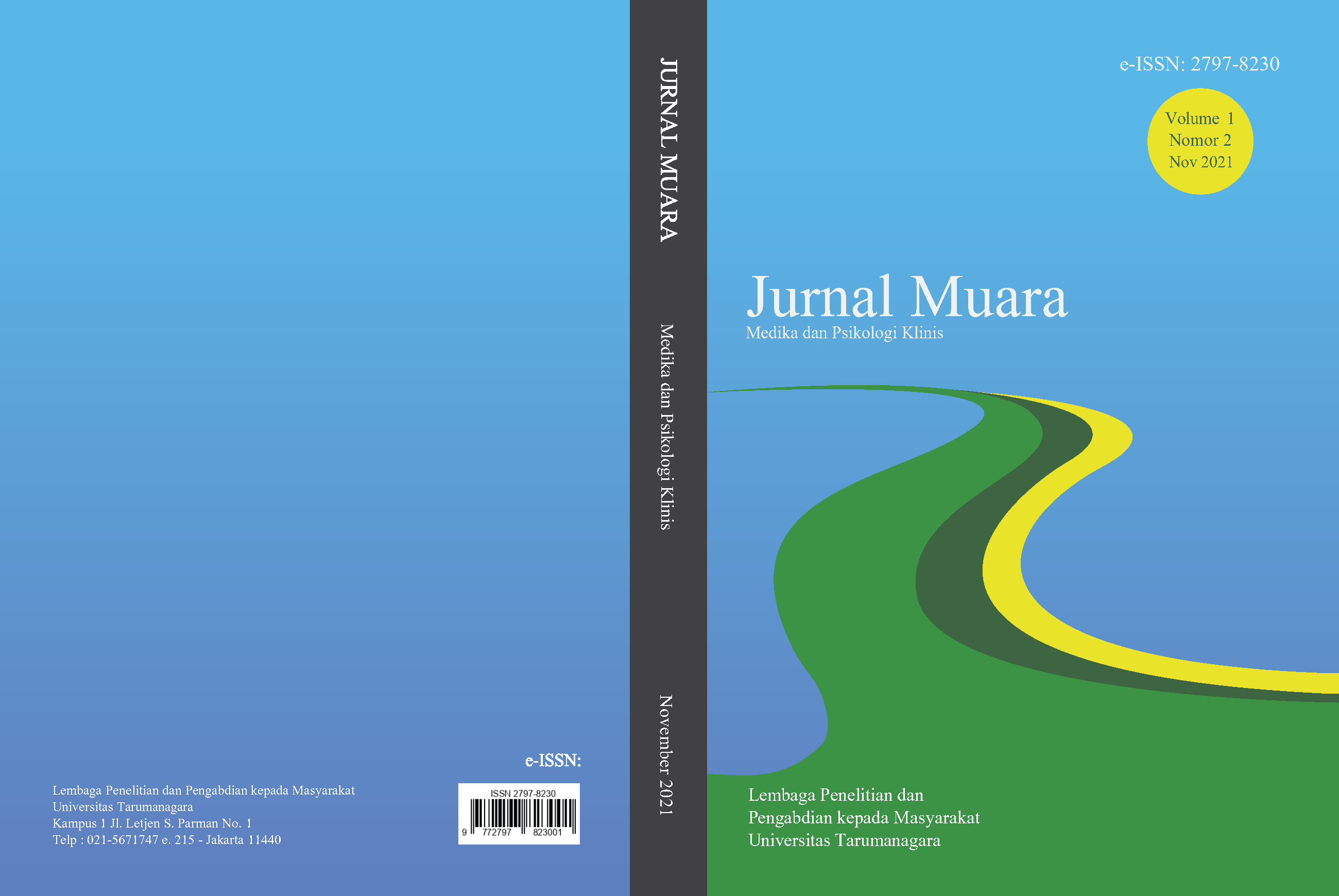Hubungan Asupan Gula Dalam Minuman Terhadap Obesitas Pada Anak Remaja Usia 15 – 19 Tahun di Sekolah SMA Notre Dame Jakarta Barat
Main Article Content
Abstract
Article Details
References
Badan Penelitian dan Pengembangan Kesehatan. (2013). Riset Kesehatan Dasar (RISKESDAS) 2013. Laporan Nasional 2013, 1–384. https://doi.org/1 Desember 2013
Badan Penelitian dan Pengembangan Kesehatan. (2018). Riset Kesehatan Dasar (Riskesdas) 2018. In Hasil Utama Riskesdas di Indonesia 2018. https://doi.org/1 Desember 2013
BPS Provinsi DKI Jakarta. (2017). Jumlah Penduduk Menurut Kelompok Umur dan Jenis kelamin di Provinsi DKI Jakarta. In BPS Provinsi DKI Jakarta. Retrieved from https://jakarta.bps.go.id/statictable/2017/01/30/142/jumlah-penduduk-menurut-kelompok-umur-dan-jenis-kelamin-di-provinsi-dki-jakarta-2015.html
Chiolero, A., Faeh, D., Paccaud, F., & Cornuz, J. (2008). Consequences of smoking for body weight, body fat distribution, and insulin resistance. The American Journal of Clinical Nutrition, 87(4), 801–809. https://doi.org/10.1093/ajcn/87.4.801
Ebbeling, C. B., Feldman, H. A., Chomitz, V. R., Antonelli, T. A., Gortmaker, S. L., Osganian, S. K., & Ludwig, D. S. (2014). A randomized trial of sugar-sweetened beverages and adolescent body weight. World Review of Nutrition and Dietetics, 109, 5–6. https://doi.org/10.1159/000356352
Gadalla, Y. M., Adil, A.-M., Mustafa, B. M., & Abdo, H. (2012). Prevalence of smoking among school adolescents in Khartoum State. Sudanese Journal of Paediatrics, 12(2), 44–48. Retrieved from http://www.ncbi.nlm.nih.gov/pubmed/27493344
Hales, C. M., Carroll, M. D., Fryar, C. D., & Ogden, C. L. (2017). Prevalence of Obesity Among Adults and Youth: United States, 2015–2016. NCHS Data Brief, 288(288), 1–8. https://doi.org/10.1017/S1368980017000088
Hargens, T. A., Kaleth, A. S., Edwards, E. S., & Butner, K. L. (2013). Association between sleep disorders, obesity, and exercise: a review. Nature and Science of Sleep, 5, 27–35. https://doi.org/10.2147/NSS.S34838
Heymsfield, S. B., & Wadden, T. A. (2017). Mechanisms, Pathophysiology, and Management of Obesity. New England Journal of Medicine, 376(3), 254–266. https://doi.org/10.1056/nejmra1514009
Kersten, S. (2001). Mechanisms of nutritional and hormonal regulation of lipogenesis. EMBO Reports, 2(4), 282–286. https://doi.org/10.1093/embo-reports/kve071
Kurdanti, W., Suryani, I., Syamsiatum, N. H., Siwi, L. P., & Adityanti, M. M. (2015). Faktor-faktor yang mempengaruhi kejadian obesitas pada remaja. Jurnal Gizi Klinik Indonesia, 11(04), 179–190. https://doi.org/10.22146/ijcn.22900
Lloyd-Jones, D. M., Hong, Y., Labarthe, D., Mozaffarian, D., Appel, L. J., Van Horn, L., … Rosamond, W. D. (2010). Defining and setting national goals for cardiovascular health promotion and disease reduction: The american heart association’s strategic impact goal through 2020 and beyond. Circulation, 121(4), 586–613. https://doi.org/10.1161/CIRCULATIONAHA.109.192703
Mahfouz, A. A., Shatoor, A. S., Khan, M. Y., Daffalla, A. A., Mostafa, O. A., & Hassanein, M. A. (2008). Nutrition, Physical Activity, and Gender Risks for Aldolescent Obesity in Southwestern Saudi Arabia. Journal of Youth and Adolescence, 37(9), 1111–1122. https://doi.org/10.1007/s10964-008-9281-z
Ogden, C. L., Kit, B. K., Carroll, M. D., & Park, S. (2011). Consumption of Sugar Drinks in the United States. NCHS Data Brief, (71), 2005–2008.
Oktaviani, W. D., Saraswati, L. D., & Rahfiludin, M. Z. (2012). Hubungan Kebiasaan Konsumsi Fast Food, Aktifitas Fisik, Pola Konsumsi, Karakteristik remaja dan Orang Tua dengan Indeks Massa Tubuh (IMT). Jurnal Kesehatan Masyarakat, 1(2), 542–553. https://doi.org/10.13292/j.1000-4890.2015.0059
Paksarian, D., Rudolph, K. E., He, J.-P., & Merikangas, K. R. (2015). School Start Time and Adolescent Sleep Patterns: Results From the U.S. National Comorbidity Survey--Adolescent Supplement. American Journal of Public Health, 105(7), 1351–1357. https://doi.org/10.2105/AJPH.2015.302619
Pentz, M. A., Brannon, B. R., Charlin, V. L., Barrett, E. J., MacKinnon, D. P., & Flay, B. R. (1989). The power of policy: the relationship of smoking policy to adolescent smoking. American Journal of Public Health, 79(7), 857–862. https://doi.org/10.2105/AJPH.79.7.857
Putri, K. A. W. K. (2016). Pemanfaatan Gadget Pada Mahasiswa Universitas Muhammadiyah Surakarta. Universitas Muhammadiyah Surakarta.
Qoirinasari, Simanjuntak, B. Y., & Kusdalinah. (2018). BERKONTRIBUSIKAH KONSUMSI MINUMAN MANIS TERHADAP BERAT BADAN BERLEBIH PADA REMAJA? 3(3), 88–94. https://doi.org/10.30867/action.v3i2.86
Ranjit, N., Evans, M. H., Byrd-Williams, C., Evans, A. E., & Hoelscher, D. M. (2010). Dietary and activity correlates of sugar-sweetened beverage consumption among adolescents. Pediatrics, 126(4), e754-61. https://doi.org/10.1542/peds.2010-1229
Rusyadi, S. (2017). Pola Makan Dan Tingkat Aktifitas Fisik Mahasiswa Dengan Berat Badan Berlebih Di Universitas Negeri Yogyakarta. Universitas Negeri Yogyakarta.
Taheri, S., Lin, L., Austin, D., Young, T., & Mignot, E. (2004). Short Sleep Duration Is Associated with Reduced Leptin, Elevated Ghrelin, and Increased Body Mass Index. PLoS Medicine, 1(3), e62. https://doi.org/10.1371/journal.pmed.0010062
Ventura, E. E., Davis, J. N., & Goran, M. I. (2011). Sugar content of popular sweetened beverages based on objective laboratory analysis: Focus on fructose content. Obesity, 19(4), 868–874. https://doi.org/10.1038/oby.2010.255
World Health Organization (WHO). (2012). Childhood obesity prevention. International Journal of Obesity, 23(s5), s44–s45. https://doi.org/10.1038/sj.ijo.0800994


